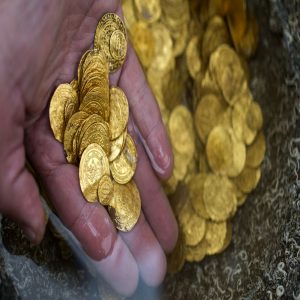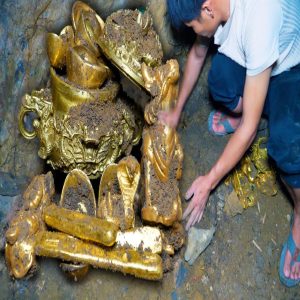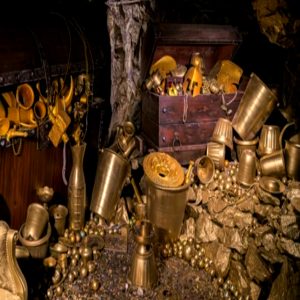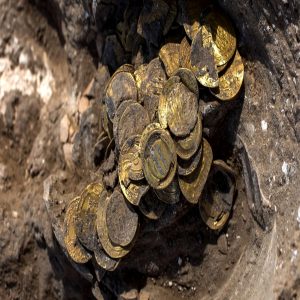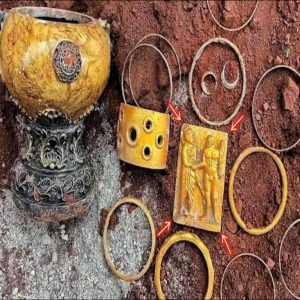On the Norwegian island of Rennesøy, an impressive hoard of ancient gold items, weighing over 100 grams, has been uncovered. The cache includes nine coin-like gold pendants or medallions, with rare horse symbols, ten gold beads, and three gold rings! Having significant value even today, the finds have been described as Norway’s “gold find of the century”.
An Unusual Find: Huge Volumes of Norway Gold
According to a press release by the Museum of Archaeology in Stavanger, Ole Madsen from the Archaeological Museum at the University of Stavanger, remarked that ‘finding so much gold at the same time is unusual’.
The discovery was made by 51-year-old metal-detectorist, Erlend Bore, from Sola, on an evening walk on the advice of his doctor, who’d bought his first metal detector just last summer as a hobby. He’d obtained prior permission to carry out this hunt on private land, and post discovery, contacted the local council who contacted the museum.
“At first I thought I’d found chocolate money with a gold wrapper, or play money,” said Bore, quoted by the same press release. The finds have been dated to the 6th century AD, making them 1500 years old.

Erlend Bore, metal detectorist aficionado, stumbled upon one of the largest Norway gold treasures found in the last 100 years.
In accordance with Norwegian legislation, the use of a metal detector is permitted when the landowner has granted explicit consent and it adheres to the guidelines outlined in the Norwegian Cultural Heritage Act of 1978. Objects that predate the year 1537 and coins minted prior to 1650 are classified as state-owned artifacts and necessitate reporting to the appropriate authorities.

A collection of the hoard before cleaning. (Museum of Archaeology/UiS)
Bracteates: Flat, Gold Pendants Resembling Coins
The circular and flat gold pendants discovered by Bore resemble coins but are actually better known as ‘bracteates’. Bracteates are flat and delicate gold pendants that bear a stamped design on one side. In many discoveries, collections of bracteates typically showcase various motifs. However, in this particular instance, all nine bracteates feature identical depictions.
“A thin sheet of gold is pressed down on a bronze stamp, so that a motif is impressed on it,” explains Dagfinn Skre, a Professor of archaeology at the Museum of Cultural History in Oslo, telling Science in Norway.
Long ago, these nine bracteates once comprised an eye-catching necklace, as revealed by Håkon Reiersen, an associate professor at the Museum of Archaeology in Stavanger.

This represents the former appearance of the necklace, featuring nine slender gold medallions known as bracteates. (Theo Eli Gil Bell/Museum of Archaeology/UiS)
“This piece of jewelry was made by skilled gold smiths and worn by the most powerful in society. It’s very rare to find so many bracteates together. We have not had any finds that compare to this since the 19th century,” added Riersen, as per the same Science in Norway report.
The Significance of the Burials: A Time of Distress and Upheaval
The obvious question that comes to mind is –why were many bracteates buried roughly in the same area? And what do they represent?
This period in Norwegian (and larger Scandinavian history) was known as the Migration Period (transitioning into the Merovingian Age around 550). It was a period marked by crises, including crop failures, deteriorating climate conditions, and plagues. In fact, the large-scale migrations of this time led to the ultimate fall of the Western Roman Empire in 476 AD, reports The Daily Mail.
Considering the location of the Rennesøy treasure’s discovery and drawing parallels with similar findings, Reiersen posits that the gold treasure may have been concealed for safekeeping or potentially offered to the gods during times of dire need.
Approximately 1000 bracteates have been unearthed in Scandinavia, but the ones discovered in Rennesøy are considered of an unusual variety, as stated by Sigmund Oehrl, a Professor at the Museum of Archaeology in Stavanger who specializes in bracteates and their symbolism.
Typically, the common imagery on these circular gold plates portrays the god Odin healing his son Balder’s ailing horse. According to Oehrl, this myth held significance as a symbol of rejuvenation and rebirth during the Migration Period. It was believed to bestow protection and good health upon its possessor.
However, the Rennesøy bracteates exhibit a simpler depiction, featuring only a horse. “The motif found on these bracteates differs from what has been observed in other gold pendants thus far,” remarked Oehrl in the press release.

One of the 9 Norway gold pendants or bracteates found in Rennesøy. (Museum of Archaeology/UiS)
“In these gold pendants, the horse’s tongue is hanging out, and its slumping posture and the twisted legs show that it is hurt. Just as with the Christian symbol of the cross which was becoming widespread in the Roman Empire at the time, this horse symbol represented disease and distress, but at the same time also hope of healing and new life,” Oehrl concludes.
In summation, it was likely that the bracteates were gifts bestowed by local kings upon their most trusted associates. In this manner, the bracteates may have functioned as a form of prestigious recognition, effectively showcasing the individuals whom the king held in the highest regard throughout the region.
After comparing similar finds from Denmark during this period, it was very likely that over the years, families may have amassed collections of bracteates as a result of their enduring loyalty to specific kings. Thus, these are indicators of an exalted social status, apart from their intrinsic values.

